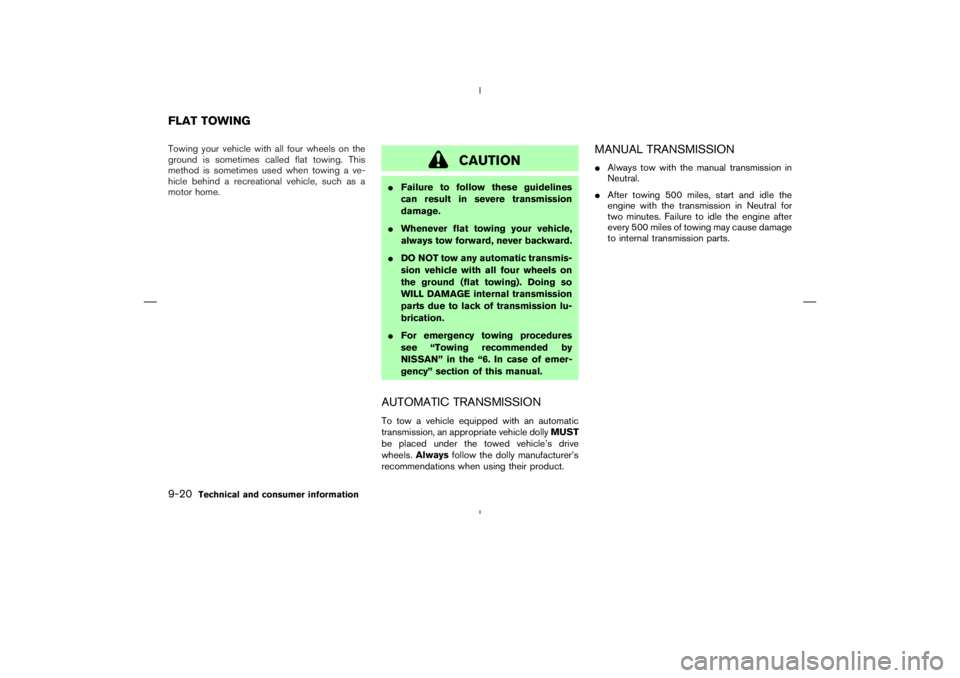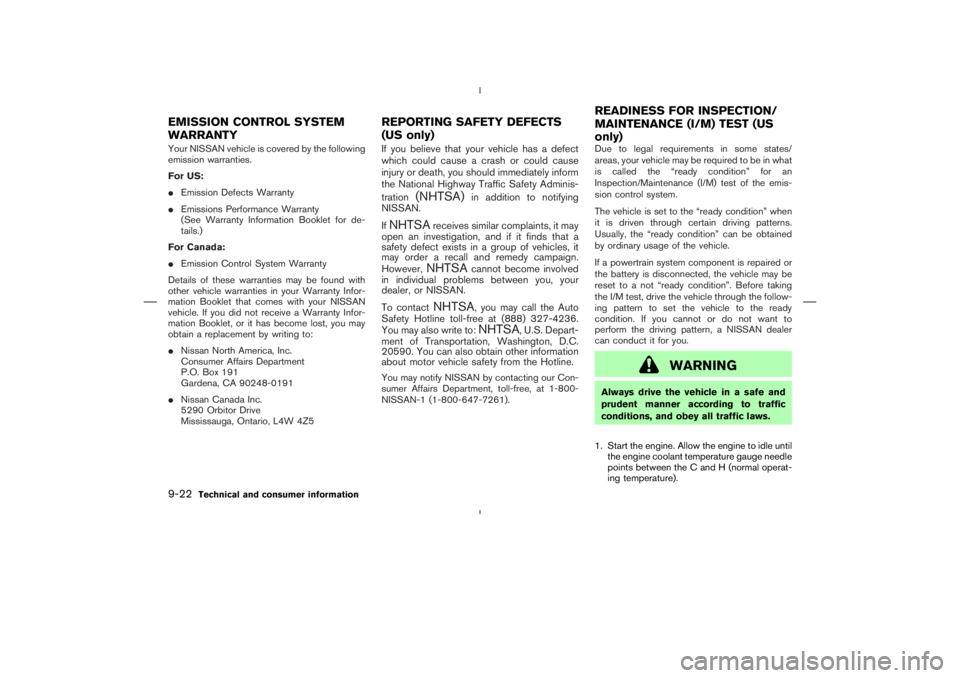Page 238 of 262
ENGINE SERIAL NUMBERThe number is stamped on the engine as shown.
F.M.V.S.S. CERTIFICATION LABELThe Federal Motor Vehicle Safety Standards
(F.M.V.S.S.) certification label is affixed as
shown. This label contains valuable vehicle in-
formation, such as: Gross Vehicle Weight Rat-
ings (GVWR), Gross Axle Weight Rating
(GAWR), month and year of manufacture, Ve-
hicle Identification Number (VIN), etc. Review it
carefully.
EMISSION CONTROL
INFORMATION LABELThe emission control information label is at-
tached as shown.
STI0303
STI0322
STI0323
Technical and consumer information
9-11
�
04.5.17/Z33-D/V5.0
�
Page 247 of 262

Towing your vehicle with all four wheels on the
ground is sometimes called flat towing. This
method is sometimes used when towing a ve-
hicle behind a recreational vehicle, such as a
motor home.
CAUTION
�Failure to follow these guidelines
can result in severe transmission
damage.
�Whenever flat towing your vehicle,
always tow forward, never backward.
�DO NOT tow any automatic transmis-
sion vehicle with all four wheels on
the ground (flat towing). Doing so
WILL DAMAGE internal transmission
parts due to lack of transmission lu-
brication.
�For emergency towing procedures
see “Towing recommended by
NISSAN” in the “6. In case of emer-
gency” section of this manual.AUTOMATIC TRANSMISSIONTo tow a vehicle equipped with an automatic
transmission, an appropriate vehicle dollyMUST
be placed under the towed vehicle’s drive
wheels.Alwaysfollow the dolly manufacturer’s
recommendations when using their product.
MANUAL TRANSMISSION�Always tow with the manual transmission in
Neutral.
�After towing 500 miles, start and idle the
engine with the transmission in Neutral for
two minutes. Failure to idle the engine after
every 500 miles of towing may cause damage
to internal transmission parts.
FLAT TOWING9-20
Technical and consumer information
�
04.5.17/Z33-D/V5.0
�
Page 248 of 262

DOT (Department Of Transportation) Quality
Grades: All passenger car tires must conform to
federal safety requirements in addition to these
grades.
Quality grades can be found where applicable
on the tire sidewall between tread shoulder and
maximum section width. For example:
Treadwear 200 Traction AA Temperature ATreadwearTreadwear grade is a comparative rating based
on tire wear rate when tested under controlled
conditions on specified government test
courses. For example, a tire graded 150 would
wear one and a half (1-1/2) times as well on the
government course as a tire graded 100. How-
ever, relative tire performance depends on actual
driving conditions, and may vary significantly
from the norm due to variations in driving habits,
service practices and differences in road char-
acteristics and climate.Traction AA, A, B and CThe traction grades, from highest to lowest, are
AA, A, B, and C. Those grades represent the
tire’s ability to stop on wet pavement as mea-
sured under controlled conditions on specified
government test surfaces of asphalt and con-crete. A tire marked C may have poor traction
performance.
WARNING
The traction grade assigned to your ve-
hicle tires is based on straight-ahead
braking traction tests, and does not in-
clude acceleration, cornering, hydro-
planing, or peak traction characteristics.Temperature A, B and CTemperature grades are A (the highest), B, and
C. They represent a tire’s resistance to heat
build-up, and its ability to dissipate heat when
tested under controlled conditions on a speci-
fied indoor laboratory test wheel. Sustained high
temperature can cause tire material to degener-
ate, reducing tire life. Excessive temperatures
can lead to sudden tire failure. Grade C corre-
sponds to a performance level which all passen-
ger car tires must meet under the Federal Motor
Vehicle Safety Standard No. 109. Grades A and
B represent higher levels of performance on
laboratory test wheels than the minimum re-
quired by law.
WARNING
The temperature grade for this tire is
established for a tire that is properly
inflated and not overloaded. Excessive
speed, underinflation, or excessive
loading, either separately or in combi-
nation, can cause heat buildup and pos-
sible tire failure.
UNIFORM TIRE QUALITY
GRADING
Technical and consumer information
9-21
�
04.5.17/Z33-D/V5.0
�
Page 249 of 262

Your NISSAN vehicle is covered by the following
emission warranties.
For US:
�Emission Defects Warranty
�Emissions Performance Warranty
(See Warranty Information Booklet for de-
tails.)
For Canada:
�Emission Control System Warranty
Details of these warranties may be found with
other vehicle warranties in your Warranty Infor-
mation Booklet that comes with your NISSAN
vehicle. If you did not receive a Warranty Infor-
mation Booklet, or it has become lost, you may
obtain a replacement by writing to:
�Nissan North America, Inc.
Consumer Affairs Department
P.O. Box 191
Gardena, CA 90248-0191
�Nissan Canada Inc.
5290 Orbitor Drive
Mississauga, Ontario, L4W 4Z5
If you believe that your vehicle has a defect
which could cause a crash or could cause
injury or death, you should immediately inform
the National Highway Traffic Safety Adminis-
tration
(NHTSA)
in addition to notifying
NISSAN.
If
NHTSA
receives similar complaints, it may
open an investigation, and if it finds that a
safety defect exists in a group of vehicles, it
may order a recall and remedy campaign.
However,NHTSA
cannot become involved
in individual problems between you, your
dealer, or NISSAN.
To contact
NHTSA
, you may call the Auto
Safety Hotline toll-free at (888) 327-4236.
You may also write to:NHTSA
, U.S. Depart-
ment of Transportation, Washington, D.C.
20590. You can also obtain other information
about motor vehicle safety from the Hotline.
You may notify NISSAN by contacting our Con-
sumer Affairs Department, toll-free, at 1-800-
NISSAN-1 (1-800-647-7261).Due to legal requirements in some states/
areas, your vehicle may be required to be in what
is called the “ready condition” for an
Inspection/Maintenance (I/M) test of the emis-
sion control system.
The vehicle is set to the “ready condition” when
it is driven through certain driving patterns.
Usually, the “ready condition” can be obtained
by ordinary usage of the vehicle.
If a powertrain system component is repaired or
the battery is disconnected, the vehicle may be
reset to a not “ready condition”. Before taking
the I/M test, drive the vehicle through the follow-
ing pattern to set the vehicle to the ready
condition. If you cannot or do not want to
perform the driving pattern, a NISSAN dealer
can conduct it for you.
WARNING
Always drive the vehicle in a safe and
prudent manner according to traffic
conditions, and obey all traffic laws.
1. Start the engine. Allow the engine to idle until
the engine coolant temperature gauge needle
points between the C and H (normal operat-
ing temperature).
EMISSIONCONTROL SYSTEM
WARRANTYREPORTING SAFETY DEFECTS
(US only)READINESS FOR INSPECTION/
MAINTENANCE (I/M) TEST (US
only)9-22
Technical and consumer information
�
04.5.17/Z33-D/V5.0
�
Page:
< prev 1-8 9-16 17-24